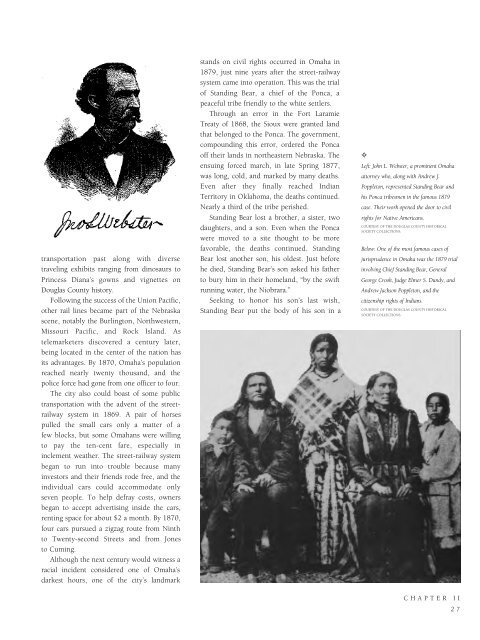Historic Omaha
An illustrated history of Omaha and the Douglas County area, paired with the histories of companies, families and organizations that make the region great.
An illustrated history of Omaha and the Douglas County area, paired with the histories of companies, families and organizations that make the region great.
You also want an ePaper? Increase the reach of your titles
YUMPU automatically turns print PDFs into web optimized ePapers that Google loves.
transportation past along with diverse<br />
traveling exhibits ranging from dinosaurs to<br />
Princess Diana’s gowns and vignettes on<br />
Douglas County history.<br />
Following the success of the Union Pacific,<br />
other rail lines became part of the Nebraska<br />
scene, notably the Burlington, Northwestern,<br />
Missouri Pacific, and Rock Island. As<br />
telemarketers discovered a century later,<br />
being located in the center of the nation has<br />
its advantages. By 1870, <strong>Omaha</strong>’s population<br />
reached nearly twenty thousand, and the<br />
police force had gone from one officer to four.<br />
The city also could boast of some public<br />
transportation with the advent of the streetrailway<br />
system in 1869. A pair of horses<br />
pulled the small cars only a matter of a<br />
few blocks, but some <strong>Omaha</strong>ns were willing<br />
to pay the ten-cent fare, especially in<br />
inclement weather. The street-railway system<br />
began to run into trouble because many<br />
investors and their friends rode free, and the<br />
individual cars could accommodate only<br />
seven people. To help defray costs, owners<br />
began to accept advertising inside the cars,<br />
renting space for about $2 a month. By 1870,<br />
four cars pursued a zigzag route from Ninth<br />
to Twenty-second Streets and from Jones<br />
to Cuming.<br />
Although the next century would witness a<br />
racial incident considered one of <strong>Omaha</strong>’s<br />
darkest hours, one of the city’s landmark<br />
stands on civil rights occurred in <strong>Omaha</strong> in<br />
1879, just nine years after the street-railway<br />
system came into operation. This was the trial<br />
of Standing Bear, a chief of the Ponca, a<br />
peaceful tribe friendly to the white settlers.<br />
Through an error in the Fort Laramie<br />
Treaty of 1868, the Sioux were granted land<br />
that belonged to the Ponca. The government,<br />
compounding this error, ordered the Ponca<br />
off their lands in northeastern Nebraska. The<br />
ensuing forced march, in late Spring 1877,<br />
was long, cold, and marked by many deaths.<br />
Even after they finally reached Indian<br />
Territory in Oklahoma, the deaths continued.<br />
Nearly a third of the tribe perished.<br />
Standing Bear lost a brother, a sister, two<br />
daughters, and a son. Even when the Ponca<br />
were moved to a site thought to be more<br />
favorable, the deaths continued. Standing<br />
Bear lost another son, his oldest. Just before<br />
he died, Standing Bear’s son asked his father<br />
to bury him in their homeland, “by the swift<br />
running water, the Niobrara.”<br />
Seeking to honor his son’s last wish,<br />
Standing Bear put the body of his son in a<br />
✧<br />
Left: John L. Webster, a prominent <strong>Omaha</strong><br />
attorney who, along with Andrew J.<br />
Poppleton, represented Standing Bear and<br />
his Ponca tribesmen in the famous 1879<br />
case. Their work opened the door to civil<br />
rights for Native Americans.<br />
COURTESY OF THE DOUGLAS COUNTY HISTORICAL<br />
SOCIETY COLLECTIONS.<br />
Below: One of the most famous cases of<br />
jurisprudence in <strong>Omaha</strong> was the 1879 trial<br />
involving Chief Standing Bear, General<br />
George Crook, Judge Elmer S. Dundy, and<br />
Andrew Jackson Poppleton, and the<br />
citizenship rights of Indians.<br />
COURTESY OF THE DOUGLAS COUNTY HISTORICAL<br />
SOCIETY COLLECTIONS.<br />
CHAPTER II<br />
27
















